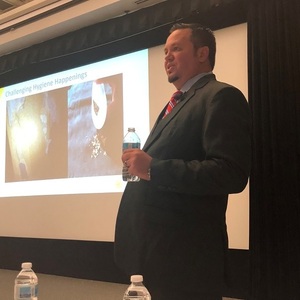Alcohol School: Tips to control contamination

PHOTO: Lisa Gibson
September 11, 2019
BY Lisa Gibson
Francois van Zyl, director of technical services for Lallemand Biofuels & Distilled Spirits, told his audience at The Alcohol School Sept. 11 that identifying contamination in yeast can be as easy as using a fluorescent microscope. The annual cost related to contamination can exceed $5 million, he said. “How many microscopes can you buy with $5 million?” It justifies basic monitoring, he said.
Lallemand’s Alcohol School is being held Sept. 9-13 at Intercontinental Montreal in Montreal, Quebec. The sessions Sept. 11 were held at National Research Council Canada, with tours of Lallemand’s research lab spaces on site.
“Time is money,” van Zyl said. The longer a contamination sits, the more money it costs. Contamination can also be detected through nonmechanical means, such as pH curve and titration of total acidity.
Advertisement
He emphasized managing the four Ts: time, titration, temperature and turbulence. “Ninety-eight percent of the time, people do not follow this rule,” he said. Cleaning takes time but, done well, can be efficient. Generally, warm detergent solutions clean better than cold solutions. For titrations, stronger solutions do clean better, van Zyl said. There should never be issues with turbulence, he said. Pipes require a minimum cleaning solution velocity of five feet per second of effective cleaning.
To troubleshoot contamination events, real-time tests are required, he said. Simple techniques can include a sample test, looking for step changes. van Zyl emphasized more than once that it’s crucial to understand the process.
Concentrate on the four Ts, document all changes made, remove dirt and sanitize, van Zyl said.
van Zyl also said he is a supporter of mechanical solutions. “You can resolve a lot of your own costs just by paying attention to detail.”
Advertisement
Related Stories
CoBank’s latest quarterly research report, released July 10, highlights current uncertainty around the implementation of three biofuel policies, RFS RVOs, small refinery exemptions (SREs) and the 45Z clean fuels production tax credit.
The U.S. Energy Information Administration maintained its forecast for 2025 and 2026 biodiesel, renewable diesel and sustainable aviation fuel (SAF) production in its latest Short-Term Energy Outlook, released July 8.
XCF Global Inc. on July 10 shared its strategic plan to invest close to $1 billion in developing a network of SAF production facilities, expanding its U.S. footprint, and advancing its international growth strategy.
U.S. fuel ethanol capacity fell slightly in April, while biodiesel and renewable diesel capacity held steady, according to data released by the U.S. EIA on June 30. Feedstock consumption was down when compared to the previous month.
XCF Global Inc. on July 8 provided a production update on its flagship New Rise Reno facility, underscoring that the plant has successfully produced SAF, renewable diesel, and renewable naphtha during its initial ramp-up.
Upcoming Events










